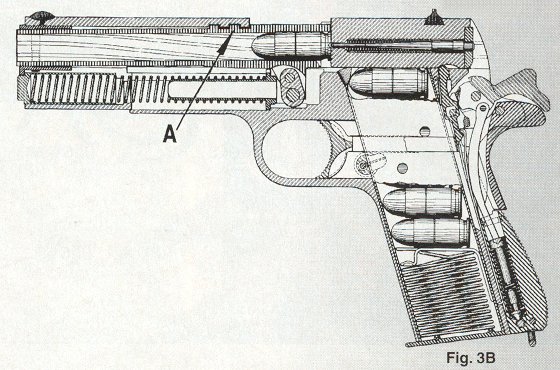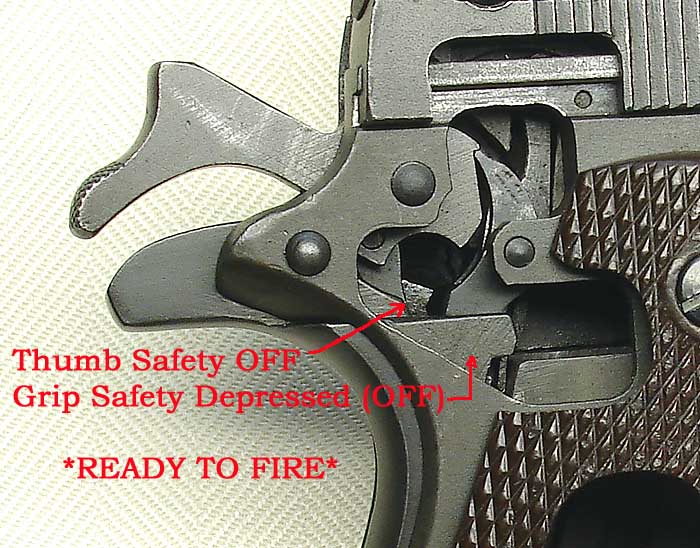I cannot address the Ashani, having not examined one, however I will discuss some aspects of the M1903 Pocket Pistol.
The first concept that needs to be addressed is the inertia firing pin of the 1911 and the later M1903. Is it safe to carry the 1911 "cocked and locked," i.e., a round in the chamber, hammer cocked, and the safety applied? Is i safe to carry the M1903 in this same condition?
The answer, in most cases, is "NO."
Here is a picture of the 1911 action, showing the firing pin:

The thing to note here is tha the firing pin, if the hammer is down, will not touch the primer of the round in the chamber. So, how does the firing pin detonate the primer?
The answer is, the hammer hits the firing pin with such force that the inertia of the firing pin is sufficient to set off the primer. It has been known for quite some time that, if a 1911 was dropped "cocked and locked" from a sufficient height, the firing pin could move with enough inertia to cause the weapon to discharge. You may take Massad Ayoob's word for this:
(from http://www.tactical-life.com/combat-han ... discharge/)Let’s look inside the guns in question. Not until the 1930s did the 1911 pistol get a positive internal firing pin lock, the Swartz safety, and Colt history students know that it was so complex and expensive to manufacture that after production was stopped with the coming of WWII, Colt never offered that option again. Not until the Series ’80 modification were Colt 1911s truly “drop-safe” again.
The 1911, in its many incarnations from many manufacturers, is sometimes drop-safe and sometimes not. The Colt Series ’80 and later Series ’90 are mechanically drop-safe, thanks to an internal firing pin lock that is actuated by the trigger system. Para USA pistols use the same safe system, having licensed it from Colt. The Sig Sauer 1911 pistols use it too. A number of years ago, the great modern gun designer Nehemiah Sirkis resurrected the Swartz internal firing pin safety concept, which works off the grip safety that is standard on 1911s, for Kimber. If your Kimber has a Roman numeral “II” suffix on its model number, it is so equipped. It works better today because modern CAD-CAM engineering and manufacturing makes it more cost effective to produce. Smith & Wesson uses a similar concept on their SW1911 pistol. Other companies—Springfield Armory, Ed Brown, Wilson Combat, and many more—chose to go the “drop-safe” route with light firing pins and extra-heavy firing pin springs, so the momentum of impact couldn’t send a heavy pin forward against light spring resistance and into the base of a primer with enough force to make the weapon fire. Any of these systems can work. 1911 experts say firing pin springs should be changed every 3,000 to 5,000 rounds to prevent spring fatigue and weakening.
The Series 80 and after do have this firing pin locking mechanism, as Ayoob says. This is how it works:

You will see that, when the trigger is pulled, a vertical locking pin disengages from a slot in the firing pin, allowing it to move. This prevents the weapon from going off when it is dropped.
It may be pointed out that dropping a 1911 from such a height is very unlikely, and that may be true. But this is a situation that has been noted as possible long ago, and Colt addressed it unsuccessfully long ago, but more successfully recently. Some copies of the 1911 use this same kind of mechanism. (It is used in other pistols, such as the Czech CZ52.) There is a version of the firing pin block that is actuated by the grip safety used in another 1911 clone.
So, whether you consider a 1911 unsafe in "cocked and locked" condition is a matter of judgment. However, I submit that, unless a person knows the principles of the inertia firing pin and are familiar with handling the 1911, they are not able to properly judge the safety of the weapon. All that person is doing is repeating something he heard or read.
Regarding the M1903, the answer is a little more complex. The first design of M1903s, as designed by John Browning, did not have an inertia firing pin. Nor did they have a half-cock notch. The idea of the half cock notch is, if for some reason the sear does not catch on the full cock notch, the sear will catch in the half cock notch without striking the firing pin. Later in the production of M1903s and M1908s (the 380 ACP version of the "Pocket Pistol"), the inertia firing pin and the half cock notch were added.
So, can an M1903/M1908 go off if it is carried "cocked and locked"? Yes! Here is a quote from the same article by Massad Ayoob, cited above:
However, this does not mean that the 1911 and the M1903 have an equal degree of safety when carried with a round in the chamber, cocked, and locked. They most certainly do not. This is because of the way the safety works. The 1911 has quite a marvelous design. Note:Firearms journalism recently experienced the tragic death of one of our own. Many of you have read the excellent writing of Steve Malloy. He was a regular writer for SWAT Magazine. Here are some excerpts from his memorial, as printed in the August, 2009 edition of SWAT and written by editor Denny Hansen, a man I’ve long known to be a total professional.
Denny wrote, “Longtime SWAT Magazine Contributing Editor Steve Malloy was killed in a tragic shooting accident at his home on April 16. As best as can be determined, Steve had a pistol in his waistband and when he bent over to tie his shoes, the pistol fell onto the floor and discharged—the bullet struck Steve in the chest. He was found in the garage, apparently trying to leave the home to summon aid.”
...
I’m told the weapon in question was a 1903 Colt Pocket Model pistol, carried with a live round in the chamber. It was a classic old gun that is revered by those who appreciate fine firearms. The 1903 .32 and the 1908 .380 Pocket Models have a long and honored history. Such guns were issued to Generals like Patton and Eisenhower in WWII, and to OSS personnel in the same time period. Hell, my grandfather shot an armed robber in self-defense early in the 20th century with a 1903 Colt .32 that’s still in the family: that particular gun was the first semi-automatic pistol I ever fired, before my age had two digits in it. Slim and compact, comfortable to carry, sweet of trigger pull and deadly accurate and reliable, it was the kind of pistol a “gun guy” like Malloy would appreciate.
It also did not have a secured firing pin and was not “drop-safe” against inertia fire. You don’t carry a 1903, so it doesn’t matter? Well, if you carry a 1911, it does matter, because both mechanisms were designed by John M. Browning and are remarkably similar. You aren’t going to ever drop your gun? Good that you’re the first perfect human who’s immune to error. It’s safe to say that neither you nor I are the Second Coming of the perfect human incapable of making a mistake. And these old Colt designs are not by any means the only autopistols that are not “drop-safe”!

This is how the lockwork of the 1911 looks when the safety is applied. Notice how the safety blocks the sear from moving away from the hammer and firing the pistol.

This is how the lockwork looks when the safety is removed. You can see, by comparing the two pictures, that the sear is no longer blocked from being tipped out of the hammer's full cock notch.
What is not so apparent in these two pictures is how the hammer is also blocked. Note that, on the hammer, there is a cut away portion of the hammer below the pivot pin. Also note that, above the surface on the safety that blocks the sear from moving, there is another vertical surface above it. The cut away portion of the hammer will strike this part of the safety if, for some reason, the sear should become disengaged.
What this means is, if you were to drop a 1911 on the hammer when it was in the cocked and locked position, it might be conceivable that the end of the sear could break, or the notch in the hammer could break. Even if one or both of these things happened, the hammer would still need to break the thick stud on the safety that blocks it. It is this design feature that makes the "locked" part of "cocked and locked" very strong in the 1911.
The M1903's safety, in contrast, only locks the sear in place into the hammer's cocking notch. It does not block the hammer. Therefore, the cocked and locked position of the safety on the M1903 is not as secure as it is on the 1911. (I'm sorry, I don't have a picture of this to post.)
It may be objected that the hammer on the M1903 is shrouded and cannot be struck directly when dropped. This argument does have merit. However, one should also consider that a direct blow on the hammer is not all that may be involved in a dropping accident. If parts are worn or damaged, a risk still exists that these parts can fail to hold.
I would furthermore like to mention the grip safety.
On the M1903 pistol, the grip safety, when engaged (when the pistol isn't being gripped), does engage the sear and prevent its movement. However, on the 1911, note this picture and compare it with the two above of the 1911:

In this case, you can see that the 1911 grip safety doesn't even block the sear from moving out of the hammer's cocking notch. All it does is keep the trigger from being pulled. Therefore, it really doesn't make the 1911 very much safer.
Conclusion:
Some propose using a titanium firing pin in a 1911, since a firing pin of decreased mass will not have as much inertial energy when the pistol is dropped, and be less likely to detonate a primer. Some propose a heavier firing pin spring to accomplish the same thing. These solutions may prevent an accidental discharge in situations where one might occur when a pre-Series 80 1911 is dropped. However, the firing pin is not positively locked in either of these two solutions.
As you can see, in this situation, the answer to the question: "Is it safe to carry a 1911 cocked and locked, with a round in the chamber," isn't so straightforward for 1911s before the Series 80. However, I have provided the facts here to our members, and you can take these facts, in addition to the condition of your firearm, into account when making your decisions. I think that this is a better course of action than reading some possibly (probably?) unreliable opinions on the internet or listening to some self-appointed "Expert" hold forth as the font of all knowledge.








